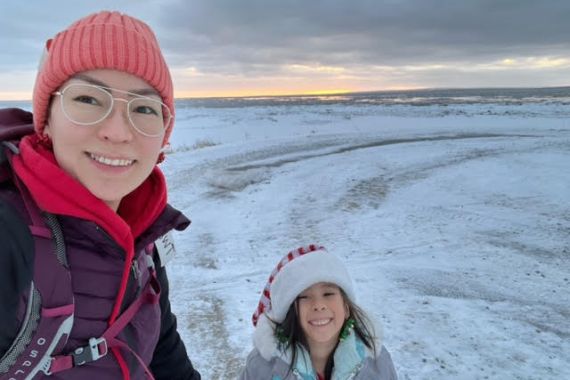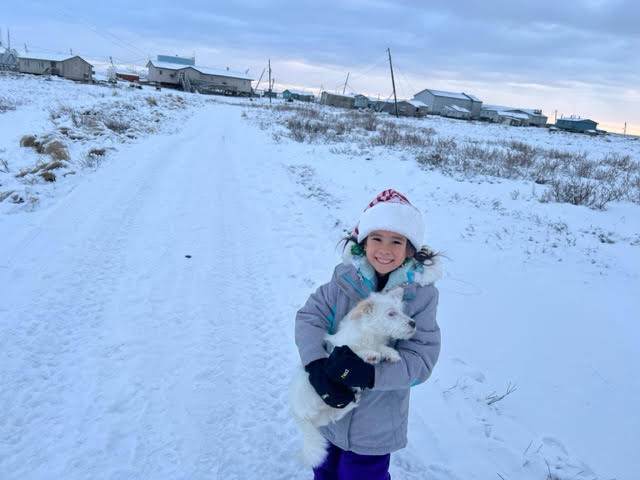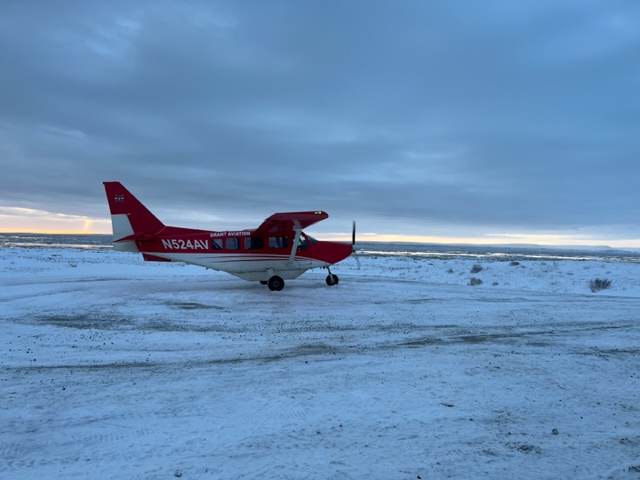Alaska Native community relocates as climate crisis ravages homes
The town of Newtok is one of the first communities in the US to collectively move because of the climate crisis.

Last week, as Carolyn George slept in her home in the small United States town of Newtok, Alaska, a scary sound jolted her awake.
“I heard a really loud bump,” George recalled in an interview with Al Jazeera. “And I felt it, too – my house fell a few inches.”
Keep reading
list of 3 itemsClimate change: Major glaciers worldwide to disappear by 2050
Is Sámi culture at risk from responses to climate change?
Perched near the Pacific Ocean, on the edge of the Ninglick River, Newtok is part of the ancestral lands of the Yup’ik people, an Indigenous group from subarctic Alaska. But the community is quickly destabilising as climate change thaws the ground, putting residents like George in danger.
That’s why Newtok has become one of the first communities in the US to collectively move to a new location because of the climate crisis.
In November, the US government announced a voluntary, community-driven relocation program, led by the Interior Department, to help tribal communities severely impacted by climate threats.
The department committed $115m from the Bipartisan Infrastructure Law and Inflation Reduction Act to assist 11 hard-hit tribes in planning relocation efforts. Of that funding, $25m is going to Newtok for its ongoing efforts to move to a safer place.
George’s home, like many in the Newtok community, faces flooding as frequent storms further erode the land. An October storm recently surrounded George’s house with water. Now when she walks, the house shakes.
It is a home she shares with one other adult, five children, two dogs and a cat.
The entire relocation plan for Newtok will cost $160m, said Sally Cox, a community resilience programmes manager for the Alaska Department of Commerce, Community and Economic Development.
Cox estimates that one-third of Newtok’s population has already moved to Mertarvik, a new community on Nelson Island, a volcanically-formed island not vulnerable to the same level of erosion.
“I’m so thankful and happy because the rest of us are still waiting to move,” George said of the federal funding.

Planning for decades
The Yup’ik people first moved to Newtok in 1949. They were previously nomadic, George explained: “They would move to camps by season by following the animals, the food.”
It was when the US Bureau of Indian Affairs built schools in Alaska, as part of an effort to assimilate Indigenous peoples into white culture, that the community was forced to relocate to the Newtok site. The town was established on what was, at the time, the furthest point up the river a barge could navigate to offload school building materials.
Newtok was constructed on permafrost, ground that is frozen all year, which makes up the majority of land in the north. It covers an estimated 23 million square kilometers (9 million square miles) in areas like Alaska, Canada, Greenland and Russia. For thousands of years, a cold climate has kept the land frozen but global heating is thawing the ice trapped inside the soil and sediment.
Across the Arctic, the permafrost is collapsing, threatening the buildings, roads, pipelines and traditional hunting and trapping territories. Permafrost also stores methane, which is released as it melts, contributing to climate change.
This year, the annual Arctic Report Card from the US National Oceanic and Atmospheric Administration (NOAA) found that the Arctic continues to warm more than twice as fast as the rest of the globe.
When George, 39, was a girl, the permafrost was intact: “The land was lush and high. The river was narrow and deep.”
But over the years, the land began to slump. “The river is widening and getting shallow. And everywhere you walk is wet now. It’s not dry like it used to be,” she said.
All that water is encouraging mould growth in homes. Floods have spread raw sewage throughout the community. Children experience asthma and impetigo, a rash caused by bacteria.
Newtok has been planning to move for decades. George first heard about the relocation effort when she was six. The relocation finally began in October 2019, when 21 households with 140 adults and children moved to Mertarvik.
Most Newtok buildings are too fragile to be moved, so the community is building new homes in Mertarvik. So far, about 28 houses have been built. The airport was recently completed, and design is beginning on the new school.
New federal strategy
Since 2015, Miyuki Hino, an environmental social scientist who works on measuring and managing climate impacts, has been researching communities that relocate due to climate change.
“It’s a hard personal decision to move for any reason, and even more so to move, not because you’re excited about a new opportunity somewhere else, but because you feel like the place that you’ve lived is no longer a safe place to be,” she said.
Offering federal funding to tribes in areas devastated by climate change, like Newtok, is a new strategy, Hino explained.
Historically, the US government hasn’t financially supported entire communities moving out of dangerous places, she explained. “We’ve been doing it household by household.”
The US Federal Emergency Management Agency (FEMA) has, for decades, bought homes from people who have experienced damage from living on floodplains. FEMA then restores the land to open space, Hino said, adding that the program is far from perfect and does not work for everyone.
“So from the US perspective, helping a whole community move at the same time away from flood-prone places, or places affected by climate change, is quite new.”

In 2016, the Jean Charles Choctaw Nation, on Isle de Jean Charles in Louisiana, became the first federally funded effort to move an entire community due to climate change.
Hino said Indigenous communities “have been paving the way in terms of showing how community planning for this can be done and also how hard it is to do within current systems in the US”.
Funding relocation home by home can work for people who don’t have close community ties, Hino said, but for Indigenous communities that share language, culture and traditions, the decision to fund a locally-led, community-scale move is also a decision to support culture.
Local, state and federal funding helps communities adapt to climate change by building sea walls or burying power lines. Hino believes relocation can be another form of managing disaster risk.
There is often a false dichotomy presented between protecting something or moving it, she explained. “There are situations where you can protect things by moving them. And creating more ways for people to do that is going to be more and more important as climate risks get worse.”

‘A big relief’
Lisa Charles, George’s cousin, lives in the new community of Mertarvik.
Her old home in Newtok had mould problems and she experienced floods mixed with sewage. Her new home is “way healthier”, she said. The heating system and filtered air exchange prevent mould.
“We don’t have any mould problems for now,” she said. Her daughter’s asthma has improved and she does not get impetigo any more.
“It’s a big relief,” Charles said.
Newtok does not have piped water and Mertarvik is the same. However, Charles has a large tank on the porch connected to the bathroom faucet, so she has running water.
Charles feels safer now. “We’re not on permafrost,” she said. “We’re on Nelson Island.”
George is looking forward to moving, like her cousin and living in a new home on stable ground. “It’ll be cleaner, we get a fresh start,” she said.